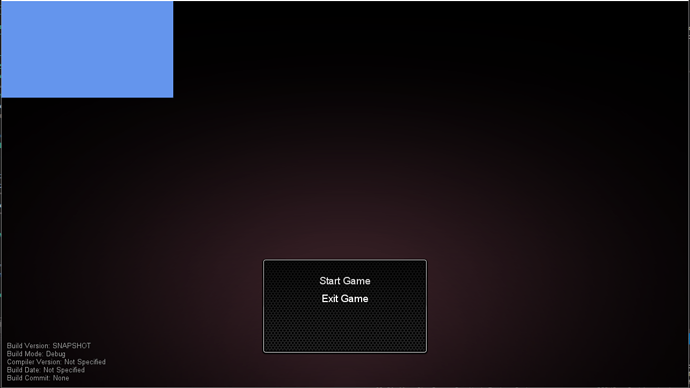Hi all,
I started to test Shader Effects on DesktopGL for Texture Generation. And I’m having some problem.
If I render just my “sprite” (actually a texture filled with CornflowerBlue with the size of my RenderTarget) and then render my target on my scene, everthing works fine:
But if I enable my effect, I get a red screen:
BUT if I render my target in the same spritebatch that my scene uses, I get my shader result all over the screen (bigger than the Render Target)
I’m not sure why this is happening. It only happens when I enable the shader effect. Here is my Shader:
#if OPENGL
#define SV_POSITION POSITION
#define VS_SHADERMODEL vs_3_0
#define PS_SHADERMODEL ps_3_0
#else
#define VS_SHADERMODEL vs_4_0_level_9_1
#define PS_SHADERMODEL ps_4_0_level_9_1
#endif
sampler TextureSampler : register(s0);
float time;
float2 resolution;
float4 main(float4 pos : SV_Position, float4 color : COLOR0, float2 texCoord : TEXCOORD0) : COLOR0
{
float2 p = (pos.xy / resolution.xy) - 0.5;
float sx = 0.2* (p.x + 0.5) * sin( 50.0 * p.x - 10.f * time);
float dy = 1.f/ ( 50.f * abs(p.y - sx) );
dy += 1.f/ (60.f * length(p - float2(p.x, 0.)));
return float4( (p.x + 0.4) * dy, 0.9 * dy, dy, 1.0 );
}
technique Technique1
{
pass Pass1
{
PixelShader = compile PS_SHADERMODEL main();
}
}
Here is how I’m rendering my “sprite” to the render target:
protected override void preDraw(GameTime gameTime) {
var graphicsDevice = Context.GraphicsDeviceManager.GraphicsDevice;
graphicsDevice.SetRenderTarget(ShaderRenderTarget);
graphicsDevice.Clear(Color.CornflowerBlue);
eff.Parameters["time"].SetValue((float)gameTime.TotalGameTime.TotalSeconds);
secondarySpriteBatch.Begin(SpriteSortMode.Immediate, BlendState.AlphaBlend);
//eff.CurrentTechnique.Passes[0].Apply(); // If I uncomment this, it gets the red screen
dummySprite.draw(secondarySpriteBatch, gameTime);
secondarySpriteBatch.End();
graphicsDevice.SetRenderTarget(null);
}
And here is how I’m rendering my Render Target:
protected override void draw(SpriteBatch spriteBatch, GameTime gameTime) {
background.draw(spriteBatch, gameTime);
shadow.draw(spriteBatch, gameTime);
changeLog.draw(spriteBatch, gameTime);
panel.draw(spriteBatch, gameTime);
startGameText.draw(spriteBatch, gameTime);
exitGameText.draw(spriteBatch, gameTime);
versionInfo.draw(spriteBatch, gameTime);
buildInfo.draw(spriteBatch, gameTime);
spriteBatch.Draw((Texture2D) ShaderRenderTarget, new Vector2(0, 0), Color.White); // My RenderTarget rendered on the corner
}
Here is how I’m initializing the Target and related stuff:
eff = Context.load<Effect>("Shaders\\TestEffect");
ShaderRenderTarget = Shader.createRenderTarget(Context.GraphicsDeviceManager.GraphicsDevice, (int) sizeW.X /4 , (int) sizeW.Y/ 4);
ShaderTexture = new Texture2D(Context.GraphicsDeviceManager.GraphicsDevice, ShaderRenderTarget.Width, ShaderRenderTarget.Height);
secondarySpriteBatch = new SpriteBatch(Context.GraphicsDeviceManager.GraphicsDevice);
dummySprite = new RectangleShape();
dummySprite.initialize(ShaderRenderTarget.Width, ShaderRenderTarget.Height, Color.CornflowerBlue);
eff.Parameters["resolution"].SetValue(sizeW);
Is this a bug or I’m doing something wrong?
Thanks!
EDIT: Here is a project I created with just the problem I’m having: https://github.com/racerxdl/ShaderTextureTest

